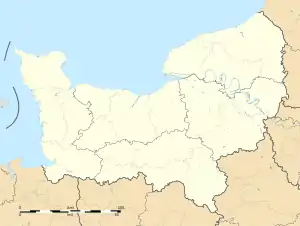Putot-en-Auge | |
|---|---|
 The church in Putot-en-Auge | |
Location of Putot-en-Auge | |
 Putot-en-Auge  Putot-en-Auge | |
| Coordinates: 49°13′06″N 0°04′02″W / 49.2183°N 0.0672°W | |
| Country | France |
| Region | Normandy |
| Department | Calvados |
| Arrondissement | Lisieux |
| Canton | Cabourg |
| Government | |
| • Mayor (2020–2026) | Alain Asmant[1] |
| Area 1 | 6.58 km2 (2.54 sq mi) |
| Population | 307 |
| • Density | 47/km2 (120/sq mi) |
| Time zone | UTC+01:00 (CET) |
| • Summer (DST) | UTC+02:00 (CEST) |
| INSEE/Postal code | 14524 /14430 |
| Elevation | 3–139 m (9.8–456.0 ft) (avg. 30 m or 98 ft) |
| 1 French Land Register data, which excludes lakes, ponds, glaciers > 1 km2 (0.386 sq mi or 247 acres) and river estuaries. | |
Putot-en-Auge (French pronunciation: [pyto ɑ̃.n‿oʒ] ⓘ, literally Putot in Auge) is a commune in the Calvados department in the Normandy region in northwestern France.
On the hill to the east of Putot a vicious battle was fought on August 19, 1944. The Allied casualties lie in the small churchyard of Putot-en-Auge.
The village features heavily in the book "13 - Lucky For Some" which is about the history of the 13th (Lancashire) Parachute Battalion. There are many then and now photographs as well as maps and diagrams of battles that took place in the region.
Population
| Year | Pop. | ±% |
|---|---|---|
| 1962 | 208 | — |
| 1968 | 202 | −2.9% |
| 1975 | 304 | +50.5% |
| 1982 | 344 | +13.2% |
| 1990 | 352 | +2.3% |
| 1999 | 330 | −6.2% |
| 2008 | 286 | −13.3% |
See also
References
- ↑ "Répertoire national des élus: les maires". data.gouv.fr, Plateforme ouverte des données publiques françaises (in French). 2 December 2020.
- ↑ "Populations légales 2021". The National Institute of Statistics and Economic Studies. 28 December 2023.
Wikimedia Commons has media related to Putot-en-Auge.
This article is issued from Wikipedia. The text is licensed under Creative Commons - Attribution - Sharealike. Additional terms may apply for the media files.